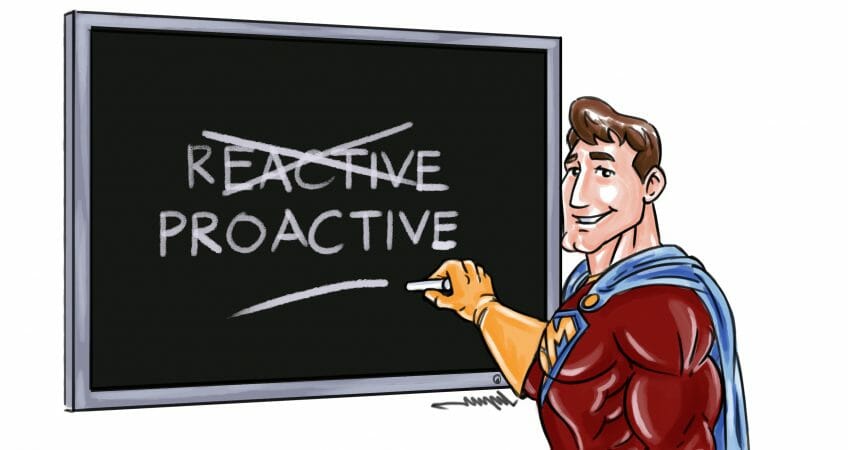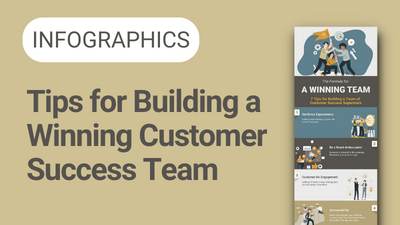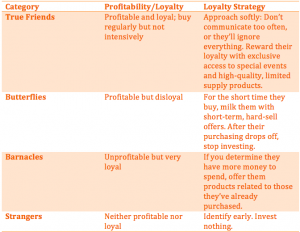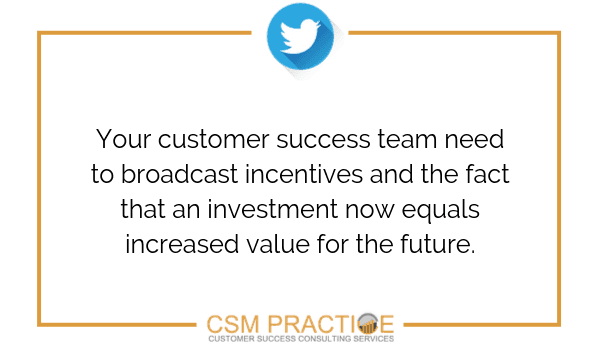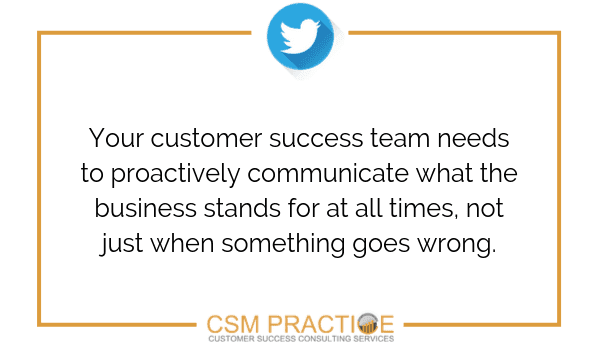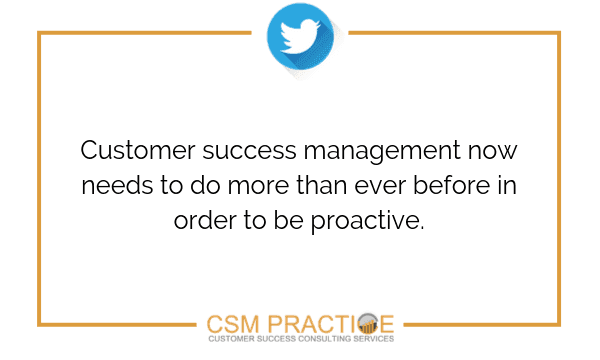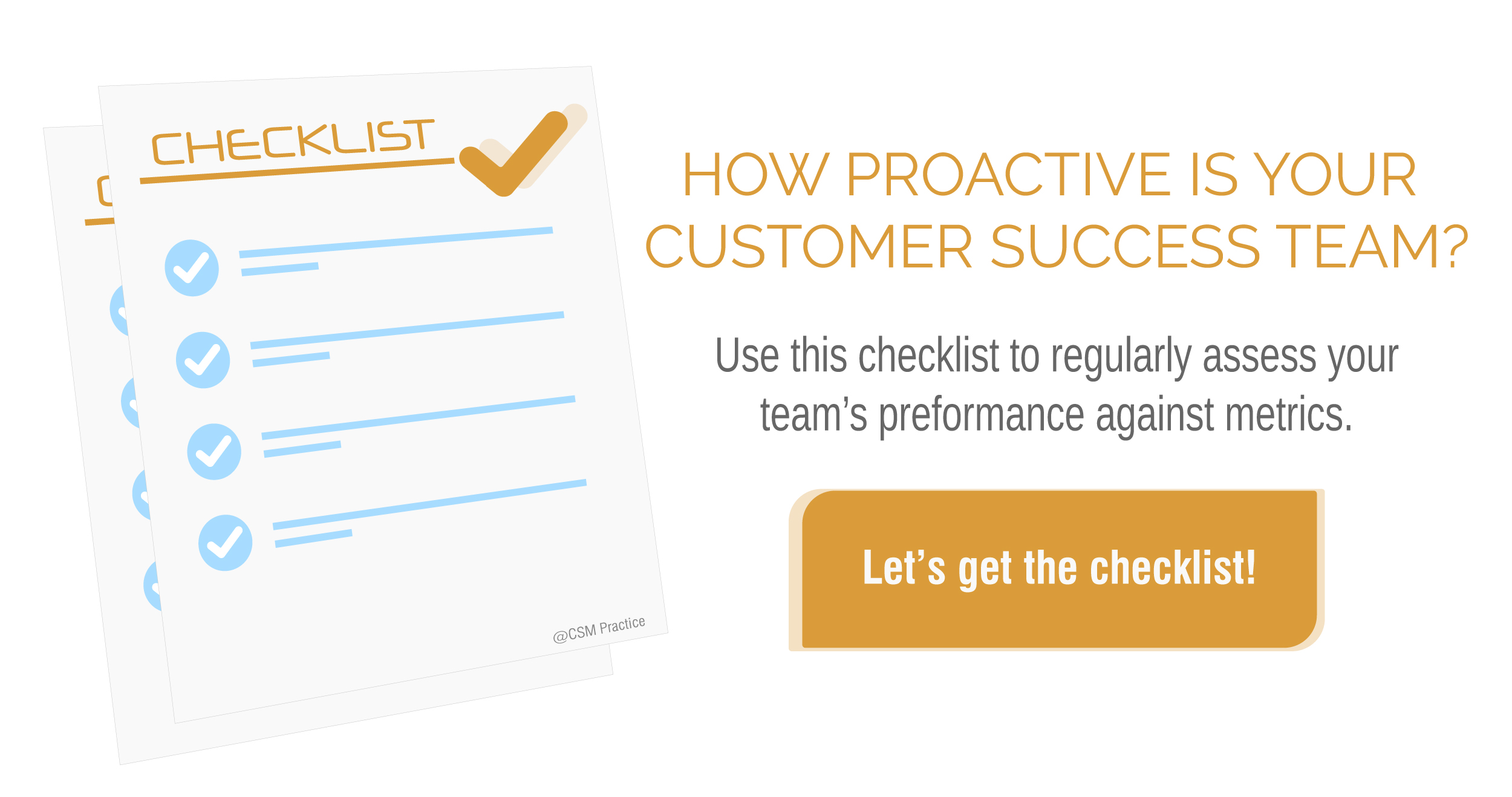Being proactive when it comes to customers is a relatively new concept. The objective has always been to deal with problems as they arise, appease unhappy customers, and repeat.
As you know, the way the world has changed, a lot. Our culture is service-based now; subscriptions, customer service and immediate replying to anyone with access to social media.
Ordinary Customer Success directors today can no longer afford to let their managers simply react to customers’ queries. Highly effective Customer Success directors, however, realize that a huge amount of value and a positive experience can be made from reaching out to their accounts proactively from the moment they begin their customer journey.
How?
By building proactive customer success management teams rather than ones who merely fight fires.
Customer Success Teams that merely apologize when necessary are consistently finding it hard to achieve results because they have few opportunities to demonstrate the potential value of the solution they are tasked to advocate for. You’ve probably seen or even experienced this yourself. A solution that doesn’t fit the description or a poorly executed service that, when brought to light, is swept quickly under the carpet, leaving customers angry, upset, and looking elsewhere.
To stop this from happening, you must enforce that the customer success manager listens, act, and prepare for the customers and the best way to do this is with a proactive Customer Success journey and effective playbooks.
Here are the 7 things you must do to turn your customer success team into a proactive trusted advisor position with your client base:
1. You Must Know your Customer Base
Ok, so everyone who has ever worked in a business, heck, worked with PEOPLE will immediately know one customer who takes up a lot of your resources, call you several times a week for help and after all, that will complain about your company to anyone who would be willing to listen. Thinking of that account, yet?! Well, that customer needs to be recognized and segmented into a certain tier in your customer base. There are so many different ways of segmenting your customers, one way that my team and I recommend is the profitability/loyalty matrix.
It may seem a little mean to call a section of your customer base a Barnacle but you get the idea… you need to be able to sort your customers into categories so you can identify where their needs, wants and of course, queries are going to lie. This analysis will then serve for developing a proactive customer journey based on playbooks that meet your customers’ desired outcomes. For example; you know that annoying customer you were thinking of before, with a matrix like this you’ll be able to see what your Customer Success team will need to put in place before launching a new service, changing an existing framework or even improving means of communication within your team now rather than later.
2. What’s in it for Me?
Before the company you work with rolls out anything new, you must think of the customers collectively asking, ‘what’s in it for me, though?’ According to Zuora, your Customer Success team needs to broadcast incentives and the fact that investment now equals increased value for the future. This has to be part of every conversation, email, blog, and event attended. This is so crucial as you reduce the risk of a customer not understanding value, taking to social media, and creating negativity about the business. If you and your team drum business value into your customer base then your customers will understand what is happening at all times and won’t have a reason to complain (Or will at least feel loyal enough to tell you privately). Here is the event link.
3. Safeguard Against Gaps
All businesses have periods in their customer journey where churn occurs. An example of this is when a subscription comes to an end. It’s a time whereby customers look elsewhere, forget to renew or feel they no longer need the product/service provided. You need to think of all the gaps, downward trends and changes your business leads customers through and safeguard against them. At CSM Practice, we offer a fantastic customer lifecycle method to help with this if you get stuck. A great way to minimize churn is to look at the point made above; fill gaps with communication about value and incentives.
Another way to fill gaps is to offer added value, such as a reduced rate with a new subscription or recognizing loyalty. However, the first thing you need to do is recognize these gaps in the first place. You can easily do this by asking leaving customers why they want to leave… businesses do this all the time, especially on websites, emails and ads. It may be painful to hear, but it’s the only way to close those gaps and minimize churn. You can discover gaps with your existing clients at any time too. A great time to do this is during your QBR or Quarterly Business Review. With you and your client together, working towards a common goal, everything will be out in the open and you will be able to properly assess all gaps and effectively tackle potential churn.
4. Downsell with Dignity
Clients over-project, their product launches fail and unforeseen circumstances arise. This means that with all the gap filling, churn minimizing, and value-adding your Customer Success team does, client success fluctuates, and sometimes they need to leave you. Or do they?
…Ok, sometimes they really do, but in most cases, Customer Success should offer a lower tier of membership/subscription. According to Business2Community.com, it means that you hold on to your customers, and you can continue to communicate with them until they can recommit to a higher level of membership. Along with down-selling, your customer success team needs to communicate that a lower membership does not equal less value or drop-in care. Keeping strong communication is paramount to a customer feeling loved and wanting to return to a higher membership level when they are ready.
5. Customer Success = Business Success
This one seems obvious, but in practice my team and I see it forgotten again and again. Customer Success cannot be expected to just get on with things. The business you work for needs to communicate with you, with other departments and in turn, they need to be communicated with. For instance, you have a direct line with customers, and therefore will be the first to hear of any new queries, and if you do hear anything new, it cannot end there! Everyone must know about it and improve things accordingly. You can find strategies to improve communication within your customer success team and cross-functional departments with our CSM Bootcamp service offering.
Similarly, the business will have a vision, a set of beliefs and a way of working, this needs to be at the forefront of everything the Customer Success team does. Look at any global business, their customers will share that business’ vision, even vocabulary: ever noticed how Apple users call their cell phones ‘iPhones’ in conversation? Or how we all talk about ‘Googling’ something? If you want this level of loyalty, then your customer success team needs to proactively communicate what the business stands for at all times, not just when something goes wrong.
6. Train Your Teams (in Teams)
Ever had a really terrible job? Maybe in a place you felt didn’t appreciate the work you did? ‘Just another cog in the machine’, sort of vibe? Well, when you work at the front lines with customers as part of a team that feeling is all too familiar. That’s not to say that your teams feel this way but often, Customer Success Management overlooks the need to praise and train their teams.
If you take time to train your teams then ensure you take a portion of that time to highlight good work carried out by specific people. Not only does this provide guidelines for others to work by, but also shows those hardworking individuals that they’re valued by management and customers alike. There’s a fantastic article by Jimbaston.com that explains more.
But this, of course, isn’t the only benefit to training teams in groups. It ensures that bad habits don’t form and spread, it allows new methods to be taught and it helps massively when it comes to scalability. Why? Because as a business grows and customer success grows with it, the way customer success works have to adapt… unfortunately, if no training takes place then you end up with team members working differently, a lack of cohesion and becoming reactive rather than proactive. We understand however that simply taking days away from your usual routine to plan and carry out training isn’t any manager’s idea of fun, that’s why we offer so much help in the form of our CSM Bootcamps where we offer live, group training tailored to your teams’ needs.
7. Certify Teams for Success
Being in a Customer Success team right now is a lot like being a personal trainer… You don’t need a certain qualification to prove it. Which is frustrating as it can promote poor quality in the profession. However, you can use others’ lack of certification to your advantage to make your teams stand out, as explained by a blog from Cicerone. Not only does being a certified Customer Success team increase loyalty and trust among clients, but it increases the motivation and retention among the members of the teams themselves. This, of course, is hugely beneficial when promoting proactivity. But how do you get your teams certified? Click here to find out (but be sure to return for this blog’s conclusion!).
What did your team do to become more proactive? Are there any systems you used to become more proactive? Please share your experience in the comments – we would love to hear from you and begin a discussion around this topic with the customer success community.
Summary
So if you’ve learned anything from this (rather meaty) blog post, it’s that Customer Success Management needs to do more now than ever before to be proactive. Now the bullet points outlined above are a great place to start if you want to restructure your Customer Success Team, but we also offer a comprehensive cheat sheet that you can download for free and use. Also, to see an immediate change you can sign up for our CSM Bootcamp and not only learn about proactivity but get help with implementing it!

